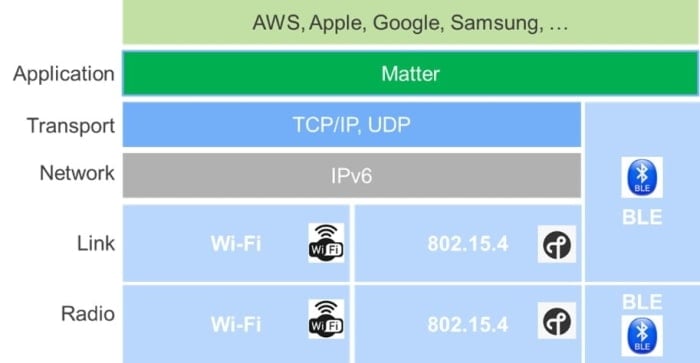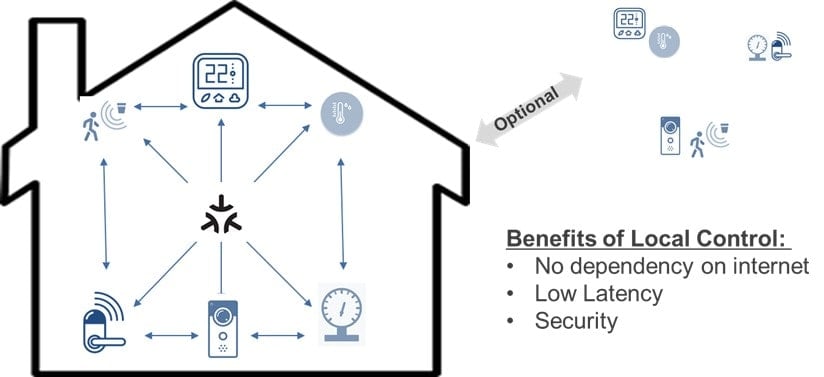IoT was supposed to make our homes comfortable, secure, and energy efficient. However, it is not happening yet. At least not for the mainstream market. The adoption of smart homes has halted at an early adopter stage. Is the main reason for the lack of adoption of smart home technologies the problem of interoperability among devices? How do you make sure that the new shiny thermostat you just bought will work with the rest of the devices at home? Does your home hub support this device? Is the protocol version (and sub-version) aligned with the requirements of the rest of the smart homes? Will you be able to tell Alexa to control it or will you need Siri for that? Will you need to install an additional app on your phone for controlling the newly added device or can an existing app on your phone do the job? The industry has been struggling with this challenge since the inception of smart homes.
Now, the good news. Matter 1.0 is finally here. Matter promises to solve this problem of interoperability. Since late 2019, the smartest and the brightest minds in the smart home industry, coming from more than 300 leading companies, have been working together to define a unified framework that aims to solve the fragmentation issues in smart homes. In technical terms, the vision of Matter is to create an IP-based protocol that securely and robustly connects various smart devices with each other, regardless of the manufacturer, and across the ecosystems. Matter is an application layer protocol that abstracts the underlying connectivity technologies such as Wi-Fi, Thread, and Bluetooth® Low Energy (LE). Using a common software stack, the device manufacturers who build with Matter will not have to worry about supporting various smart home ecosystems and voice services such as Amazon's Alexa, Apple's Siri, Google's Assistant, and others. Smart home users will be able to buy any Matter-certified device, use any voice assistant, and use any smart home platform to control their devices.

Another key feature of Matter is local control. Typical inter-device communication within smart homes happens through the cloud. Each device sends its data to the relevant cloud. APIs within different clouds allow devices to interact with each other. With Matter, devices can now communicate with each other locally without a need to send the data to the cloud. The data from devices can stay within the home network. Not only does local control provide benefits in terms of latency, security, and response times but it also ensures that the devices continue to work in case of interruption in the internet connection of the cloud service.

Ensuring a common standard for security features is another key aspect of Matter. Current IoT devices lack security. Insecure IoT devices are the cause of history’s largest DDoS attack (Mirai botnet) which brought down a huge portion of the internet in the US and Europe. The issue is that IoT device makers are usually more focused on device features and time to market while security is a "nice to have" requirement. As a result, many products sold in the market lack the necessary security capabilities. Matter solves this problem by defining the security capabilities of devices that aim to be Matter certified. For example, Root of Trust is a requirement for Matter-certified devices. All communication needs to be secure through TLS and encryption needs to be based on well-proven algorithms such as SHA256. "Ease of use" and "security" are usually considered two conflicting priorities. Matter aims to ensure safety through its comprehensive security framework without compromising user experience.
The Matter stack has been defined to keep compute and memory footprints low. Open-source Matter stack requires less than 128KB of RAM and less than 1MB of flash. Computation requirements are low and MCU class devices can easily run Matter.
Although it is just the beginning, Matter 1.0 specs already support a range of devices including lighting products (plugs, lightbulbs, switches, etc.), door locks, thermostats and HVAC controllers, blinds and shades, home security sensors (such as door and window sensors, motion sensors, and smoke and carbon monoxide detectors), garage door controllers, wireless access points and bridges, and televisions and video players. Support for security cameras, smart speakers, home appliances, and robotic vacuums is already planned for subsequent versions of Matter. With the ecosystem expansion, new use cases and applications are expected to emerge. Matter participants including Renesas are committed to enriching and enhancing the Matter ecosystem with meaningful partnerships with IoT device makers and other key stakeholders.
In short, Matter is a major step towards mass-market adoption of smart homes. IoT device makers, who build with Matter, can benefit from reduced cost and time-to-market by using open-source code with exceptional specifications. At Renesas, we are strongly committed to Matter. Renesas has all of the major connectivity technologies of Matter such as Bluetooth Low Energy, Wi-Fi, and Thread. Support for Matter is a critical piece of our strategy as a leader in the smart home connectivity space. We are engaged with major industry players for standardization activities. Our engineering teams have been working on Matter readiness. All our relevant connectivity products will be "Matter ready" going forward.
More information on Renesas' Matter support is available at www.renesas.com/Matter.
ニュース&各種リソース
| タイトル | 分類 | 日時 |
|---|---|---|
| Matter Technology FAQs | 外部リンク | 2023年2月2日 |
| ルネサス初、Matterプロトコル対応のソフトウェア開発キットを発表 | ニュース | 2023年1月5日 |
